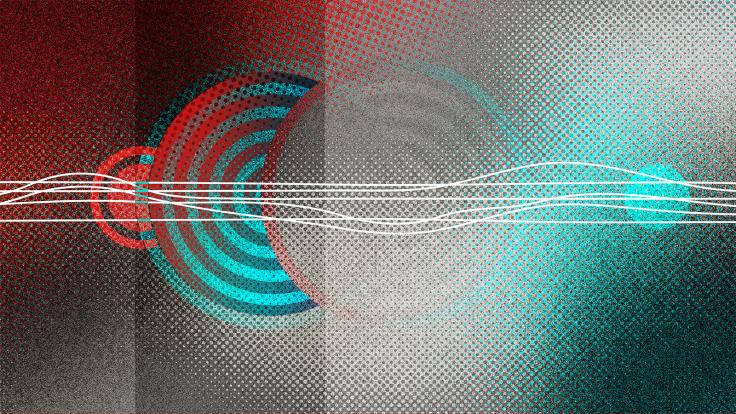In the early 1900s, physicists were trying to find the source of a low-level buzz of radiation that seemed to be present at all times, everywhere around the world. The reigning theory was that all of it came from the Earth itself.
That quickly changed, however, when the Swiss physicist Albert Gockel used a hot air balloon to take measurements of the radiation far above sea level. To his surprise, it actually increased with altitude. This strange, pervasive energy, it seemed, was coming from above even more than from below. The source? High-energy particles from space called cosmic rays.
To detect these particles, physicists began taking to the skies in balloons and refitted war planes; hiking up precarious mountainsides; and side-stepping gaping crevasses in high-elevation glaciers. They brought with them cloud chambers, transparent containers full of dense water or alcohol vapor.
When a cosmic ray collides with an atom in a cloud chamber, a shower of smaller subatomic particles careen off in all directions. These charged particles ionize vapor molecules, which become visible as thin wisps of condensation. (See our article on how to make your own cloud chamber.)
Using cloud chambers—and later detectors filled with liquid hydrogen—physicists began to realize that there are far more particles than they had initially suspected.
They discovered muons, pions, kaons and lambda particles. Then, starting in the 1930s when the first particle accelerators began operation, physicists found themselves inundated with even more new subatomic particles.
“There were so many of these particles,” says Brian Shuve, a physicist at Harvey Mudd College, “that it seemed very unlikely that they were all elementary.”
That hunch turned out to be correct. Most of the new particles would eventually be classified as “hadrons,” composite particles made up of even tinier constituents called quarks.
Hadrons include such all-star members as the protons and neutrons that make up the nuclei of atoms, but the group is much larger than that. Through decades of meticulous study, we now know that there are more than 100 different hadrons. By studying them, physicists have been able to paint a clearer picture of the four fundamental forces that explain our universe.
The periodic table of hadrons
It’s hard out there for a massive particle. Generally, the more massive a particle is, the faster it decays, releasing its energy as it falls apart into less massive particles.
Knowing this, physicists were baffled by the behavior of the some of the new particles they saw. Some of them, such as the kaons, were sticking around much longer than expected, based on their masses.
In 1952, physicists Murray Gell-Mann, Abraham Pais and Kazuhiko Nishijima introduced the concept of ‘strangeness’ to describe this property.
In 1961, Gell-Mann and physicist Yuval Ne’eman discovered that by charting a particle’s strangeness along one axis in a graph and its isospin—a quantum number related to the particle’s interaction with the strong force—along the other, they could group them into precise geometric figures.
Gell-Mann called this organization scheme the “Eightfold Way,” a term he borrowed from the Buddhist path to awakening. It allowed him to create a kind of periodic table for the hadrons.
Just as chemist Dmitri Mendeleev’s periodic table of elements initially contained gaps that allowed him to predict the existence of undiscovered elements, the Eightfold Way also contained gaps that led physicists to the discovery of new particles.
The case for quarks
In developing the Eightfold Way, Gell-Mann had crafted a puzzle with an intricate design. He knew roughly where the missing pieces were, but he couldn’t immediately make sense of the pattern.
Gell-Mann and the physicist George Zweig independently realized that the way in which hadrons were related to one another could be explained if they were actually made up of even smaller particles. Gell-Mann whimsically termed these theoretical elementary particles “quarks,” while Zweig called them “aces.”
But there were two problems with this theory.
First, in their experiments physicists had never detected anything even remotely resembling a quark. Second, and just as dire: Up until that point, the charges of all of the known particles came in whole numbers (i.e. 1, -1, 0). To make the theory of quarks or aces work, they had to have charges that were fractional.
This didn’t sit well with the established physics community, nor even with Gell-Mann himself. He ended his publication outlining the predicted properties of quarks by asking experimentalists to prove him wrong, saying, “A search for stable quarks… would help to reassure us of the non-existence of real quarks.”
Experimentalists obliged this request for several years without luck. But physicists persisted, and a series of experiments performed in the early 1970s at the US Department of Energy’s SLAC National Accelerator Laboratory—then called Stanford Linear Accelerator Center—finally drummed up evidence for the existence of these elementary particles.
Gell-Mann and Zweig were vindicated (though Gell-Mann’s name, “quarks,” won the day), and physicists had a new model for understanding the subatomic realm.
Researchers initially worked under the assumption that there were three quarks, although we now know that there are at least six, called up, down, top, bottom, charm and strange.
Most hadrons are made up of either two or three quarks.
Hadrons made up of three quarks—such as the proton and the neutron—are called baryons. (Protons contain two up quarks and a down quark, while neutrons have two down quarks and an up quark.)
Hadrons made up of two quarks are called mesons. These are bit more exotic; one of their two quarks is always an antimatter particle. Pions, for example, can either be positive, negative or neutral. Positive pions contain an up quark and an anti-down quark that are briefly pulled together in a delicate dance before decaying into a more stable form of matter.
All in all, physicists have either directly detected or otherwise inferred the existence of more than 100 different hadrons, including a few varieties of four- and even five-quark particles.
An unstable partnership
If there are so many different types of hadrons in the universe, why are protons and neutrons the only two that seem to constitute visible matter? To answer this question, we have to return to the question of stability.
Each of the six types of quark has its own mass, ranging from the light up and down quarks, each of which has a mass equal to less than a percent of the proton’s, to the top quark, which is a whopping 175 times more massive than a proton. To put that into perspective, the difference between the mass of the up quark and the top quark is roughly the difference in weight between a tennis ball and an elephant.
Since protons are made up of extremely small quarks, you might be asking where the proton gets most of its mass. You’re not alone.
“The majority of a hadron’s mass actually comes from the energy of the gluons that bind quarks together,” says Cesar Luis Da Silva, a physicist at Los Alamos National Laboratory. “But exactly how the energy of gluons translates to the mass of hadrons is a question physicists are still trying to answer.”
Hadrons made up of heavier quarks tend to be unstable due to their excess energy and thus exist only briefly before decaying into smaller particles. But the rate at which hadrons decay is governed by which force they interact with.
“Neutral pions decay 300 million times faster than charged pions, even though they have the same mass,” says Da Silva. “That’s because neutral pions decay via the electromagnetic interactions, whereas charged pions decay through the weak force.”
The proton and neutron, made up of the lightest quarks, tend to stick around. But not even those particles are necessarily safe from the ravages of time, points out Dmitri Denisov, the deputy associate lab director for High-Energy Physics at Brookhaven National Laboratory.
“Neutrons in the nucleus of atoms can live for quite a long time—up to billions of years—but as soon as they’re free of the nucleus, they decay in about 15 minutes,” he says.
No one has ever observed a proton decay, but that may only be because they remain relatively stable for such a long time. It’s possible that in the far, distant future, all protons will have decayed into other forms of matter and energy.
New combinations
As newer particle accelerators harness higher energies than their predecessors, physicists are able to create increasingly exotic particles. This has been a staple for researchers on the LHCb experiment at the Large Hadron Collider, Denisov says.
“The LHC—because it has such high energy—can create particles which contain more than two or three quarks,” he says. “Some can have four, called tetraquarks, or five—the pentaquarks.”
“Like most other hadrons, these particles are unstable and exist for mere billionths of a second,” Denisov says. “There are only a handful of them detected, and some of their properties are puzzling.”
Hadrons are still taking us to the edge of known physics and beyond. Just as the disorienting discovery of new hadrons in cloud chambers led to the theory of quarks, the new tetra- and pentaquarks may lead us to an even deeper understanding of how the universe works.














